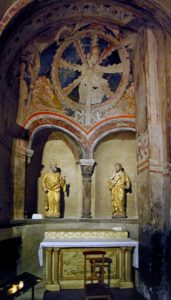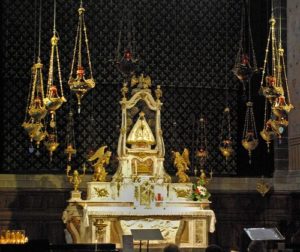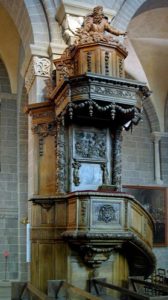Cathédrale de Notre-Dame is a World heritage Site. It was built on the site of a Roman pagan place of worship which was evangelised in the third century. There were reports of visions of the virgin Mary and miraculous cures associated with an ancient dolmen. It is an important pilgrimage site and one of starting points for pilgrimage to Santiago de Compostela.
The first building was begun about 415AD using some of the Roman masonry. Some of this carved masonry can still be seen round the back of the chancel. Side aisles were added in the 6thC and it was extended from 1000AD onwards. Most of the present building dates from the 12thC, although there was a major restoration in the 19thC. The capstone of the dolmen is now found in the floor of Saint Crucifix Chapel to the left of the altar.
The Cathedral is almost impossible to photograph. It is a huge building of dark volcanic stone. The beautiful Romanesque west front with pillars and round arches is built from black and grey volcanic stone, with striped arches and mosaic decoration at top.
Lack of flat land for the 12thC extension meant the last two bays of the nave and the west front were built above a sheer drop and supported by massive arcades. Steep steps lead up to three open archways leading to cavernous porch. We made the mistake of approaching from the side so missed the glory of the full view of the front.
The cavernous porch has two bays with vaulted ceilings. There are the remains of 13thC frescoes on the walls, underside of the arches and pillars. Facing are three huge doorways. The central door is known as the Golden Portal and has two old porphyry columns. On either side are the ‘Cedar’ Doors, which are actually carved pinewood. They date from the mid 12thC and have a strong Arab influence, a result of contact with Muslim Spain and the Crusades. The left door is carved with reliefs of the Nativity, the right door depicts the Passion of Christ. The reliefs are surrounded by mock Kufic script and Latin inscriptions in a similar style.
The staircase form the porch brings you out into the centre of the nave. On entering the cathedral the impression is of size. It has a huge nave of dark volcanic stone with massive pillars with carved capitals. The nave ceiling has six large cupolas resting on octagonal bases. The tops of the arches are built of alternating bands of dark and light stone. Chandeliers hang from the ceiling.
There is a beautifully carved 17thC pulpit with pillars and garlands. On the back wall is a scene of Jesus pardoning the adulterous woman. Above is a huge canopy with God the Father on the top. Opposite is a crucifix. Above the west end is a large highly carved wooden Baroque organ with cherubs. Below is a 17thC gilded carved wood bas relief of St Andrew on a cross with two angels bringing him the crown of martyrdom. There are several large paintings on the walls of the side aisles. At the back of the south wall is a carving of St Ann teaching the young Virgin Mary.
The high altar is a beautiful stone and gilt structure with a low retable with integral host box with a gilded door. and gilded angels. with a pelican plucking its breast to feed its young. Above is a small cupola with the famous Black Virgin statue. Pilgrims placed offerings at the foot of the statue and it was one of most precious in France until the Revolution when it was destroyed. This is 18thC copy and is made from cedar wood. It shows the Virgin dressed in white seated on a throne with the Christ Child on her lap.
Round it is a semicircle of elaborate gold and enamel hanging lamps with red lights. The back wall is painted black with white fleur-de-lis. There are two altars in the north Transept, which has old frescoes on the walls and also in the gallery above. The left hand altar has reliquary boxes and a fresco of the women at the empty tomb. The right hand altar has statues of Zaccharine and Joseph in wall niches above it. Above is a fresco depicting the martyrdom of St Catherine, tied to a wheel with sharp blades on the sides of the spokes and surrounded by angels. To the north of this is the Saint Crucifix Chapel with a carved statue of the Virgin holding the dead body of Christ.
The altars in the south transept are surrounded by brightly coloured modern murals. The left altar has a painting of St St Jean de Francois on left and the right has a gilded statue of St Joseph.
A passageway off the south aisle with a bishop’s tomb leads to the sacristy which has a small treasury as well as a bookshop.??? A door just before the sacristy gives access to the outside of the chancel. Old stone carvings along bottom of walls are thought to be Roman and include a lion and hunting scenes.
The Bell tower is 11/12thC although top was rebuilt in the 19thC. It was designed to be free standing and is a massive square stepped structure. In the base is the old Saint-Sauveur Chapel which houses 14thC tombs of two canons and a bishop.
The cloisters are to the north of the church.
This is a large and splendid building but for some reason it left us cold. It was a dull day and there was little light in the Cathedral. This with the dark stone may account for us leaving unimpressed by the building.
We did, however, enjoy the cloisters with their carved capitals.










